What We Measure
What We Measure

9 Key Performance Indicators
Your Teamlytica report gives you and your team a breakdown of each of the major nine categories within the report. All are colour-coded for ease of use.
The nine categories we score against are based on acknowledged academic, management and team diagnostics. Each question is carefully worded to ensure it can be answered by anyone completing the survey.
Each question is answered via a sliding scale of 1-10 – from ‘Never’ to ‘Always’. Each of the questions and categories are interlinked and interdependent and produce a clear and thorough diagnosis of where the team is ‘at’.

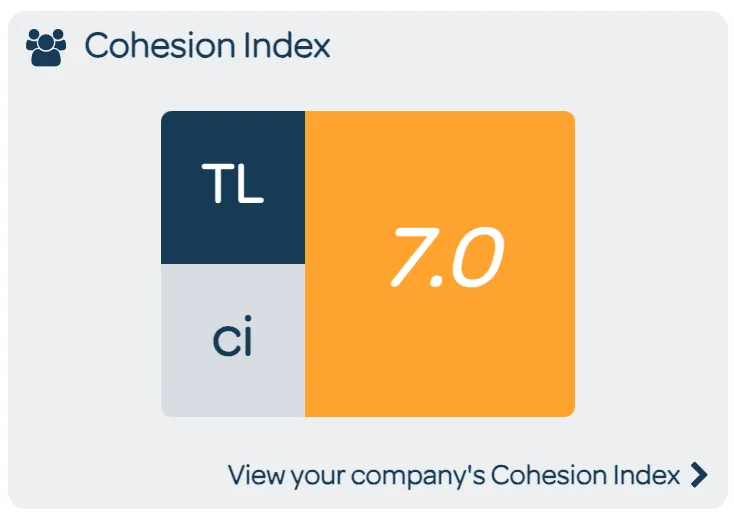
Team Cohesion
Team Cohesion
Your Teamlytica report gives you and your team a breakdown of each of the major nine categories within the report. All are colour-coded for ease of use.
The nine categories we score against are based around acknowledged academic, management and team diagnostics. Each question is carefully worded to ensure it can be answered by anyone completing the survey.
Each question is answered via a sliding scale of 1-10 – from ‘Never’ to ‘Always’. Each of the questions and categories are interlinked and inter-dependent and produce a clear and thorough diagnosis of where the team is ‘at’.
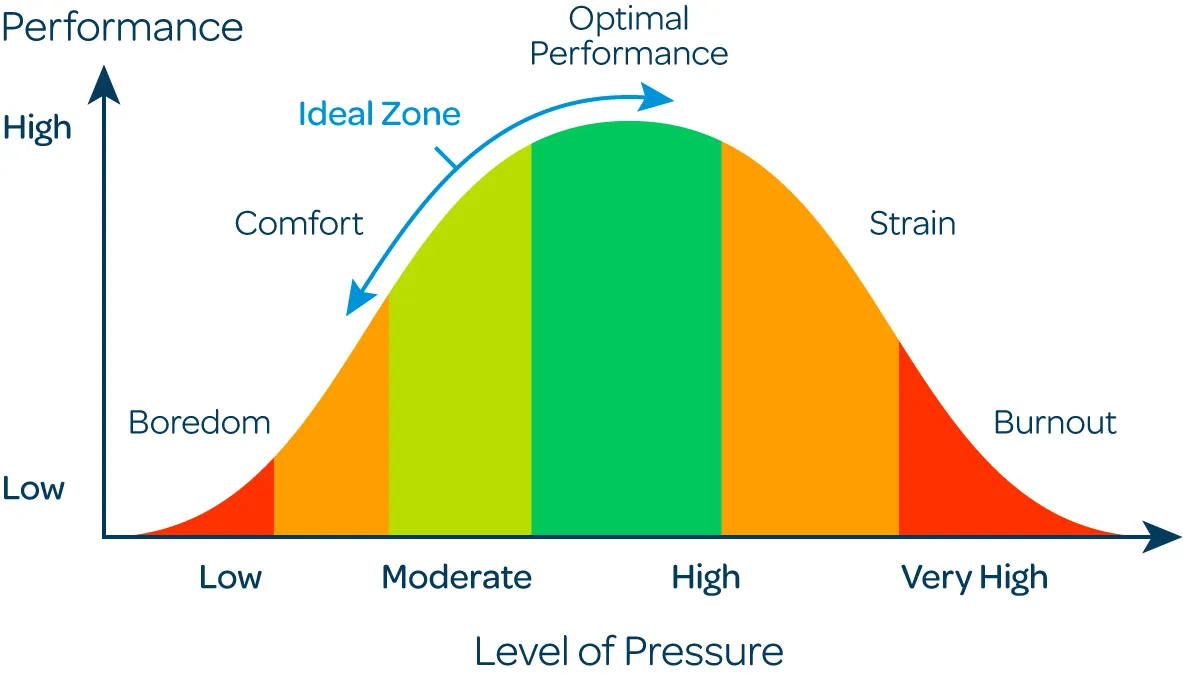
Team Stress Indicators
Team Stress Indicators
TeamLytica's stress curve analysis is a powerful tool for team leaders and members alike. By tracking the stress curve over time, teams can assess the effectiveness of their strategies for stress management and identify areas for improvement.
Understanding how stress impacts team dynamics allows for targeted interventions and the creation of a healthier and more resilient work environment.
Ultimately, by leveraging the stress curve, TeamLytica empowers teams to proactively manage stress, foster collaboration, and achieve their goals with greater efficiency and harmony.


Team Morale
Psychological safety is a fundamental aspect of high-performing teams, and at TeamLytica, we prioritise its understanding and cultivation. Psychological safety refers to an environment where team members feel safe to take risks, express their ideas, and be their authentic selves without fear of judgment or negative consequences.
It creates a space where individuals feel comfortable sharing their opinions, making mistakes, and seeking feedback. By fostering psychological safety within teams, TeamLytica helps unlock the full potential of each member, leading to increased collaboration, innovation, and overall team effectiveness.
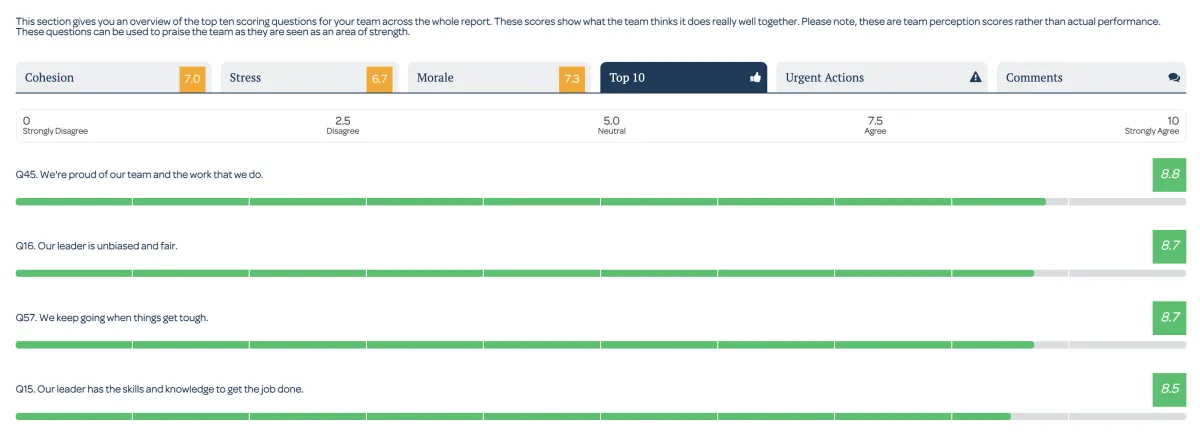
Top Ten Scores
Your Teamlytica report gives you and your team a breakdown of each of the major nine categories within the report. All are colour-coded for ease of use.
The nine categories we score against are based around acknowledged academic, management and team diagnostics. Each question is carefully worded to ensure it can be answered by anyone completing the survey.
Each question is answered via a sliding scale of 1-10 – from ‘Never’ to ‘Always’. Each of the questions and categories are interlinked and inter-dependent and produce a clear and thorough diagnosis of where the team is ‘at’.
Urgent Actions
Urgent Actions
TeamLytica's stress curve analysis is a powerful tool for team leaders and members alike. By tracking the stress curve over time, teams can assess the effectiveness of their strategies for stress management and identify areas for improvement.
Understanding how stress impacts team dynamics allows for targeted interventions and the creation of a healthier and more resilient work environment.
Ultimately, by leveraging the stress curve, TeamLytica empowers teams to proactively manage stress, foster collaboration, and achieve their goals with greater efficiency and harmony.
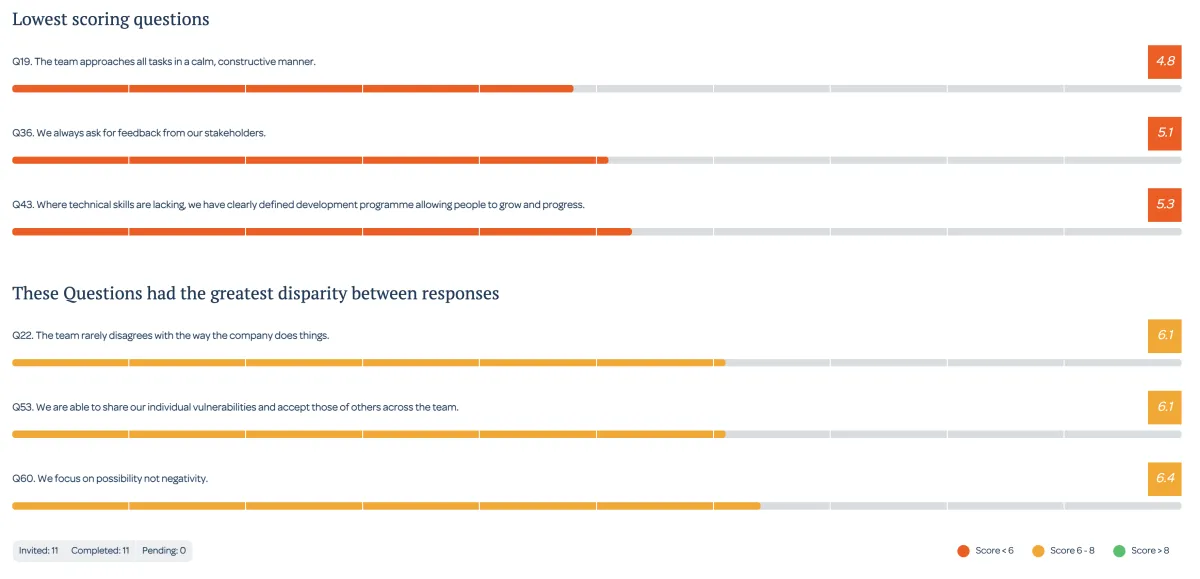

Open Text Responses
Your Teamlytica report gives you and your team a breakdown of each of the major nine categories within the report. All are colour-coded for ease of use.
The nine categories we score against are based around acknowledged academic, management and team diagnostics. Each question is carefully worded to ensure it can be answered by anyone completing the survey.
Each question is answered via a sliding scale of 1-10 – from ‘Never’ to ‘Always’. Each of the questions and categories are interlinked and inter-dependent and produce a clear and thorough diagnosis of where the team is ‘at’.
TeamLytica's Nine Categories
Our unique reporting system gathers information on the nine fundamental categories which are key to a happy, healthy team dynamic.
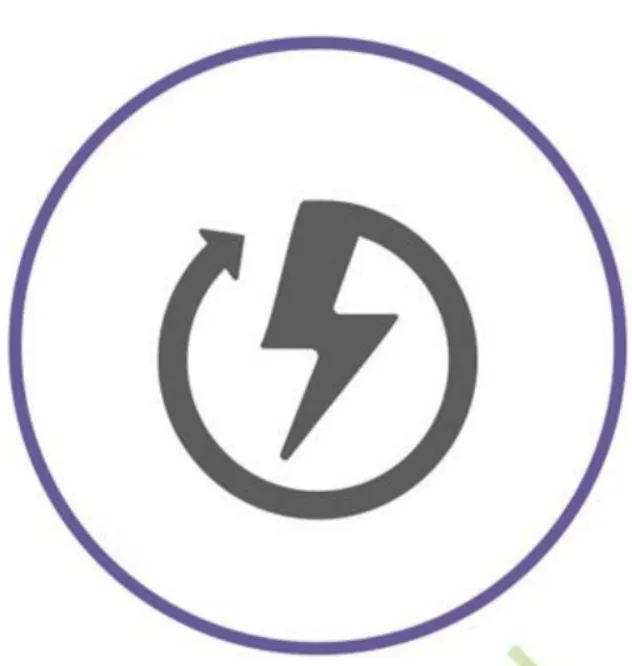
Energy
The Energy category focuses on assessing team members' motivation, enthusiasm, and engagement. It measures their passion for their work and ability to maintain high energy levels. By understanding and optimising team energy, organisations can foster productivity, creativity, and a positive work atmosphere.

Leadership
The Leadership category evaluates the effectiveness of team leaders in guiding and inspiring their members. It assesses leadership qualities, communication skills, decision-making abilities, and their impact on team performance. Effective leadership motivates team members, fosters growth, and contributes to a culture of success.

Capability
The Capability category assesses team members' skills, expertise, and knowledge. It evaluates their collective capabilities to accomplish tasks, solve problems, and meet objectives. By identifying areas for improvement and providing development opportunities, organisations can enhance their team's capabilities and achieve optimal performance.

Trust
Trust is a critical component of successful teamwork. The Trust category measures the level of trust and psychological safety within a team. It evaluates factors such as reliability, transparency, and accountability. By fostering trust, organisations create an environment where team members feel safe to take risks, express opinions, and collaborate effectively.

Delivery
The Delivery category assesses a team's ability to meet deadlines, deliver high-quality work, and fulfil commitments. It focuses on project management, efficiency, and consistent results. Organisations can optimise their delivery capabilities by identifying areas of improvement, streamlining processes, and ensuring successful outcomes.

Harmony
The Harmony category evaluates a team's cooperation, communication, and synergy. It assesses how well team members work together, resolve conflicts, and maintain a positive team atmosphere. Organisations can foster collaboration and create a harmonious work environment by nurturing effective team dynamics and encouraging a supportive culture.
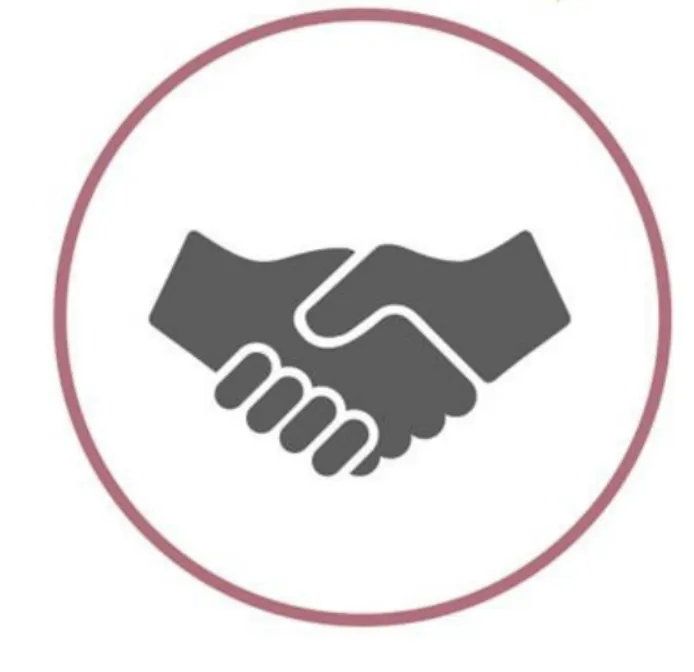
Stakeholders
The Stakeholders category assesses a team's relationship with external parties, such as clients, suppliers or partners. It evaluates how well the team understands stakeholder needs, manages expectations, and communicates effectively. Organisations can strengthen stakeholder relationships and drive success by aligning their efforts to meet these stakeholder requirements.

Accountability
The Accountability category evaluates how well team members take ownership of their responsibilities, meet commitments, and deliver on promises. It assesses personal and collective accountability within the team. Cultivating a culture of accountability fosters reliability, productivity, and overall team success.
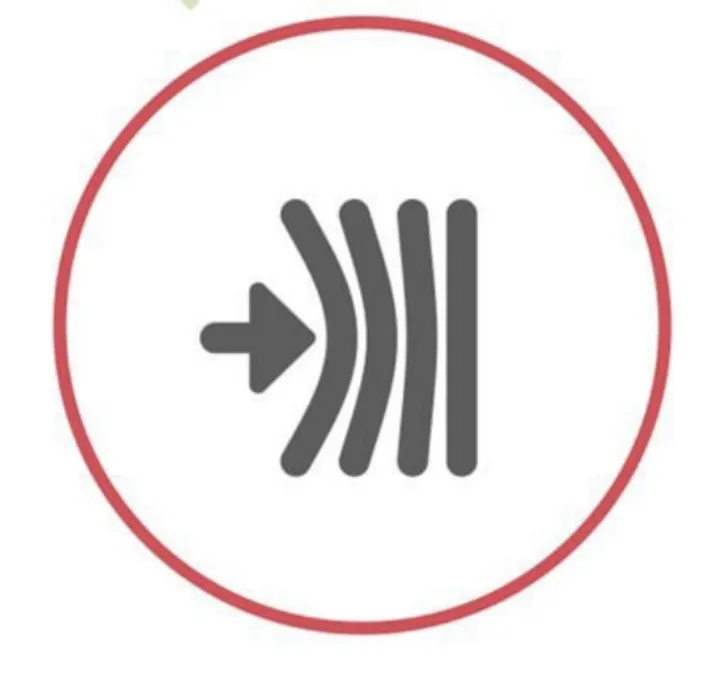
Resilience
Resilience refers to a team's ability to adapt, recover, and thrive in the face of challenges. The Resilience category evaluates how well teams cope with stress, embrace change, and overcome adversity. Organisations can enhance team resilience by providing support, promoting a growth mindset, and equipping teams with the tools to navigate obstacles
Would you like to see a TeamLytica report in action?
Enter your name and email address to receive your free Teamlytica sample report. We will deliver it directly to your Inbox.

Tyrelle Mcleod-Bentley
Director
Soccer Assist
The irony is not lost on us that we recruit and place the next generation of sports stars who all have to excel in teams. The Teamlytica platform has helped us get to a place where we're proud of our own team performances.

Anita Dev
Director
TeamWork ADL
The team reports have really helped our team and given our senior leaders the knowledge we've needed to make effective changes to the way we work and manage.

Steve Chown
Entrepreneurial Innovation Manager
TeamLytica's software has been identified as a valuable tool to check the effectiveness of newly combined teams in the Bank. We are using it to review their progress as the staff become more integrated.

Tyrelle Mcleod-Bentley
Director
Soccer Assist
The irony is not lost on us that we recruit and place the next generation of sports stars who all have to excel in teams. The Teamlytica platform has helped us get to a place where we're proud of our own team performances.

Anita Dev
Director
TeamWork ADL
The team reports have really helped our team and given our senior leaders the knowledge we've needed to make effective changes to the way we work and manage.

Steve Chown
Entrepreneurial Innovation Manager
TeamLytica's software has been identified as a valuable tool to check the effectiveness of newly combined teams in the Bank. We are using it to review their progress as the staff become more integrated.
Accredited Coaches
Only accredited coaches can use TeamLytica.
The training and support you get will ensure you have the right level of knowledge to be able to coach teams as well as individuals. Then our reporting platform gives you a strong structure, providing you with a foundation that you can build on with your own knowledge and experience.
Find out more about our solution:
Keep up to date with our
News & Blogs

Public Sector
Public Sector
Boosting teamwork and performance is challenging when budgets are being squeezed.
If you are a manager in the public sector, you face a variety of pressing challenges. The world is volatile, uncertain and ambiguous: it’s not often clear what the future holds for specific departments or processes. What’s more, technology is changing the nature of public services, reducing staffing requirements and increasing the technical complexity of the work.
Public sector teams need to be able to deliver services to the general public effectively. Dysfunctional groups create internal problems and don’t provide a level of service that taxpayers expect. Many problems begin at the team level, which is why rooting them out and fixing them is so important.
TeamLytica is a tool that does just that. It delves into the management issues that could be affecting the performance and wellbeing of your team and offers solutions to resolve them.
Using KITE – K – Knowledge, I – Insights, T – Training, E – Empowerment.
The platform uses a confidential questionnaire. Managers send a survey to their colleagues covering nine domains critical for describing the success of the team. Employees then upload their answers to the platform that automatically generates a 28-page report based on the data provided.
The report contains all kinds of valuable insights that enable you to identify issues which might be hampering the effectiveness of your team. Think of it as a diagnostic tool – a way of sniffing out problems that would otherwise be challenging to observe.
The Team Overview page provides an executive summary of team and management performance across nine critical factors: leadership, delivery, trust, capability, energy, harmony, stakeholders, accountability and resilience. You can immediately get a feel for the nature and extent of the problems afflicting your department and take actions to address them.
We aim to do things a little differently at TeamLytica – we’re here to help.
Management in the public sector is difficult; complicated partly by the high levels of unionisation. With TeamLytica, you get a range of simple, actionable steps you can take immediately, based on the findings of the survey. Key development areas could include things like helping new leaders find their feet, better communicating with employees, and training and development options to enhance the effectiveness of leaders.
What about differences in performance between teams in different departments? TeamLytica can help with that too.
Many managers in the public sector often wonder why some teams perform better than others. The TeamLytica platform provides tools that allow you to compare various departments to one another and find the metrics that might explain performance differentials. One team, for instance, might have a high level of trust in management and feel confident with reporting problems; another might not.
Public sector departments also rely heavily on a select few “star” employees: people with the knowledge and expertise to keep the show running. TeamLytica allows you to important key performance metrics and cross-correlate them with employee satisfaction measures from the survey. You’re then immediately able to see whether you’re at risk of losing your most valuable people and adopting management strategies to address this.
The public sector faces management challenges from a changing workforce to people empowerment. It’s vital, therefore, that you use TeamLytica’s tools to uncover the problems holding your team back so that you can continue to deliver to the public.












